Critical Analysis of Clinical Redesign Process: A Healthcare Report
VerifiedAdded on 2023/06/04
|7
|1641
|82
Report
AI Summary
This report provides a critical analysis of the clinical redesign process in healthcare. It begins by outlining the author's central arguments, which emphasize the importance of leadership involvement, setting stretch goals, and focusing on the patient journey. The report then discusses the implications for health leadership and management, highlighting the role of managers in ensuring high-quality patient care and the sustainability of healthcare services. The analysis also points out the shortcomings of the article, such as the lack of specific implementation steps and the absence of discussion on maintaining current procedures. The report draws on the redesign clinical process undertaken by Flinders Medical Center and New South Wales, emphasizing the significance of continuous improvement and the integration of new technologies to enhance healthcare service delivery, patient flow, safety, and health outcomes. The report concludes by underscoring the importance of management in mandating policies, motivating staff, and ensuring the sustainability of healthcare practices.

Critical Analysis of Clinical Redesign Process
Student’s Name
Course
Date
Student’s Name
Course
Date
Paraphrase This Document
Need a fresh take? Get an instant paraphrase of this document with our AI Paraphraser
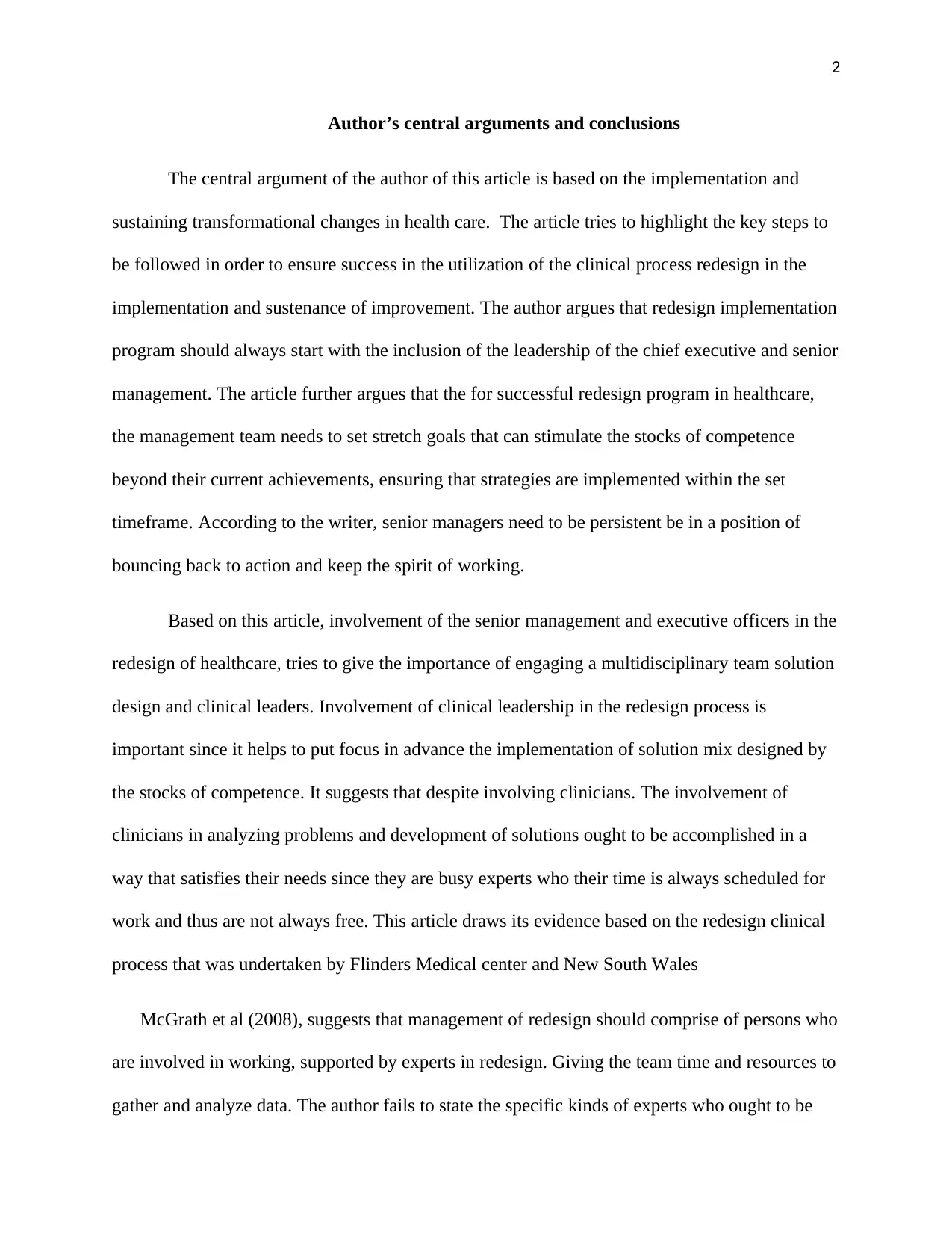
2
Author’s central arguments and conclusions
The central argument of the author of this article is based on the implementation and
sustaining transformational changes in health care. The article tries to highlight the key steps to
be followed in order to ensure success in the utilization of the clinical process redesign in the
implementation and sustenance of improvement. The author argues that redesign implementation
program should always start with the inclusion of the leadership of the chief executive and senior
management. The article further argues that the for successful redesign program in healthcare,
the management team needs to set stretch goals that can stimulate the stocks of competence
beyond their current achievements, ensuring that strategies are implemented within the set
timeframe. According to the writer, senior managers need to be persistent be in a position of
bouncing back to action and keep the spirit of working.
Based on this article, involvement of the senior management and executive officers in the
redesign of healthcare, tries to give the importance of engaging a multidisciplinary team solution
design and clinical leaders. Involvement of clinical leadership in the redesign process is
important since it helps to put focus in advance the implementation of solution mix designed by
the stocks of competence. It suggests that despite involving clinicians. The involvement of
clinicians in analyzing problems and development of solutions ought to be accomplished in a
way that satisfies their needs since they are busy experts who their time is always scheduled for
work and thus are not always free. This article draws its evidence based on the redesign clinical
process that was undertaken by Flinders Medical center and New South Wales
McGrath et al (2008), suggests that management of redesign should comprise of persons who
are involved in working, supported by experts in redesign. Giving the team time and resources to
gather and analyze data. The author fails to state the specific kinds of experts who ought to be
Author’s central arguments and conclusions
The central argument of the author of this article is based on the implementation and
sustaining transformational changes in health care. The article tries to highlight the key steps to
be followed in order to ensure success in the utilization of the clinical process redesign in the
implementation and sustenance of improvement. The author argues that redesign implementation
program should always start with the inclusion of the leadership of the chief executive and senior
management. The article further argues that the for successful redesign program in healthcare,
the management team needs to set stretch goals that can stimulate the stocks of competence
beyond their current achievements, ensuring that strategies are implemented within the set
timeframe. According to the writer, senior managers need to be persistent be in a position of
bouncing back to action and keep the spirit of working.
Based on this article, involvement of the senior management and executive officers in the
redesign of healthcare, tries to give the importance of engaging a multidisciplinary team solution
design and clinical leaders. Involvement of clinical leadership in the redesign process is
important since it helps to put focus in advance the implementation of solution mix designed by
the stocks of competence. It suggests that despite involving clinicians. The involvement of
clinicians in analyzing problems and development of solutions ought to be accomplished in a
way that satisfies their needs since they are busy experts who their time is always scheduled for
work and thus are not always free. This article draws its evidence based on the redesign clinical
process that was undertaken by Flinders Medical center and New South Wales
McGrath et al (2008), suggests that management of redesign should comprise of persons who
are involved in working, supported by experts in redesign. Giving the team time and resources to
gather and analyze data. The author fails to state the specific kinds of experts who ought to be
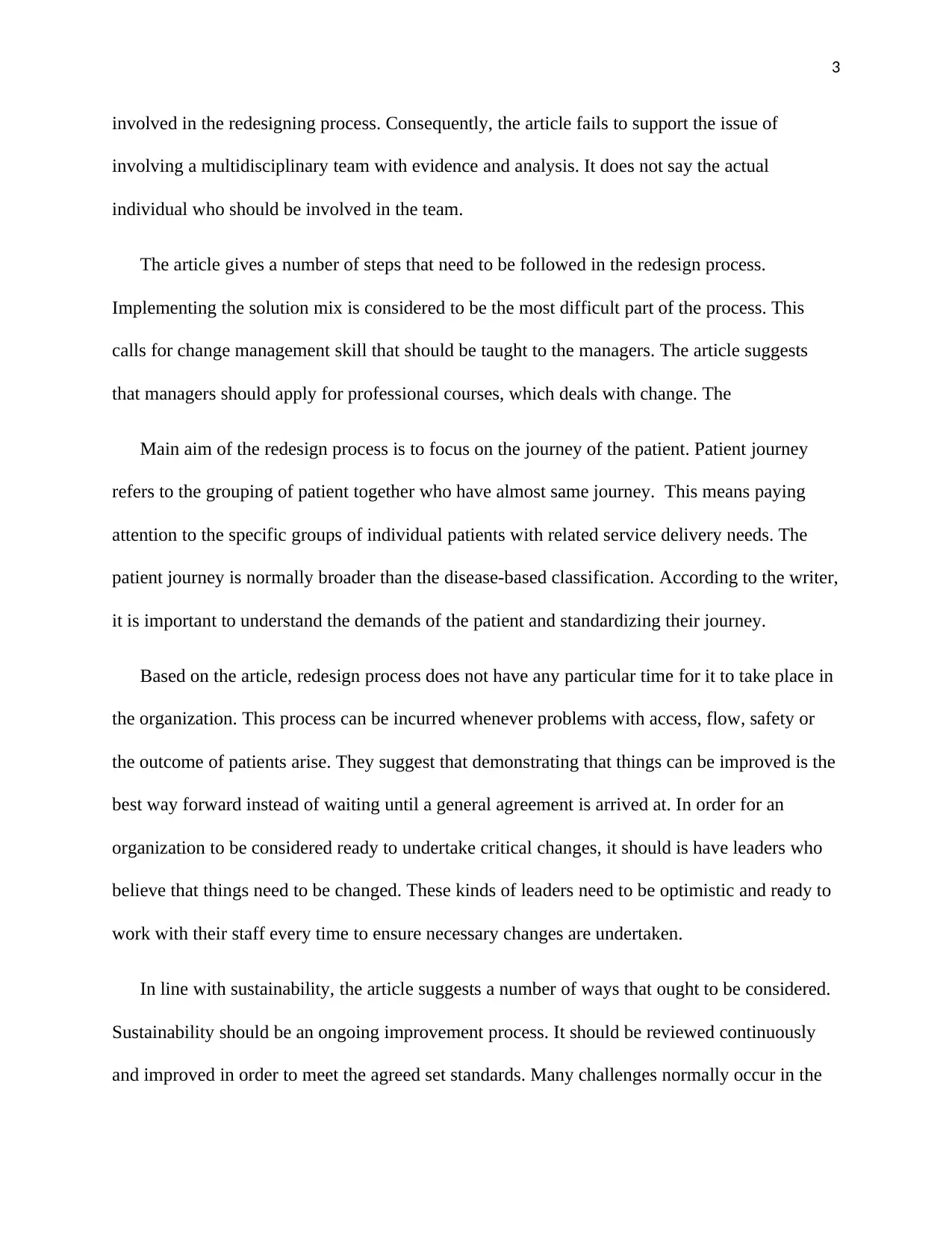
3
involved in the redesigning process. Consequently, the article fails to support the issue of
involving a multidisciplinary team with evidence and analysis. It does not say the actual
individual who should be involved in the team.
The article gives a number of steps that need to be followed in the redesign process.
Implementing the solution mix is considered to be the most difficult part of the process. This
calls for change management skill that should be taught to the managers. The article suggests
that managers should apply for professional courses, which deals with change. The
Main aim of the redesign process is to focus on the journey of the patient. Patient journey
refers to the grouping of patient together who have almost same journey. This means paying
attention to the specific groups of individual patients with related service delivery needs. The
patient journey is normally broader than the disease-based classification. According to the writer,
it is important to understand the demands of the patient and standardizing their journey.
Based on the article, redesign process does not have any particular time for it to take place in
the organization. This process can be incurred whenever problems with access, flow, safety or
the outcome of patients arise. They suggest that demonstrating that things can be improved is the
best way forward instead of waiting until a general agreement is arrived at. In order for an
organization to be considered ready to undertake critical changes, it should is have leaders who
believe that things need to be changed. These kinds of leaders need to be optimistic and ready to
work with their staff every time to ensure necessary changes are undertaken.
In line with sustainability, the article suggests a number of ways that ought to be considered.
Sustainability should be an ongoing improvement process. It should be reviewed continuously
and improved in order to meet the agreed set standards. Many challenges normally occur in the
involved in the redesigning process. Consequently, the article fails to support the issue of
involving a multidisciplinary team with evidence and analysis. It does not say the actual
individual who should be involved in the team.
The article gives a number of steps that need to be followed in the redesign process.
Implementing the solution mix is considered to be the most difficult part of the process. This
calls for change management skill that should be taught to the managers. The article suggests
that managers should apply for professional courses, which deals with change. The
Main aim of the redesign process is to focus on the journey of the patient. Patient journey
refers to the grouping of patient together who have almost same journey. This means paying
attention to the specific groups of individual patients with related service delivery needs. The
patient journey is normally broader than the disease-based classification. According to the writer,
it is important to understand the demands of the patient and standardizing their journey.
Based on the article, redesign process does not have any particular time for it to take place in
the organization. This process can be incurred whenever problems with access, flow, safety or
the outcome of patients arise. They suggest that demonstrating that things can be improved is the
best way forward instead of waiting until a general agreement is arrived at. In order for an
organization to be considered ready to undertake critical changes, it should is have leaders who
believe that things need to be changed. These kinds of leaders need to be optimistic and ready to
work with their staff every time to ensure necessary changes are undertaken.
In line with sustainability, the article suggests a number of ways that ought to be considered.
Sustainability should be an ongoing improvement process. It should be reviewed continuously
and improved in order to meet the agreed set standards. Many challenges normally occur in the
⊘ This is a preview!⊘
Do you want full access?
Subscribe today to unlock all pages.

Trusted by 1+ million students worldwide
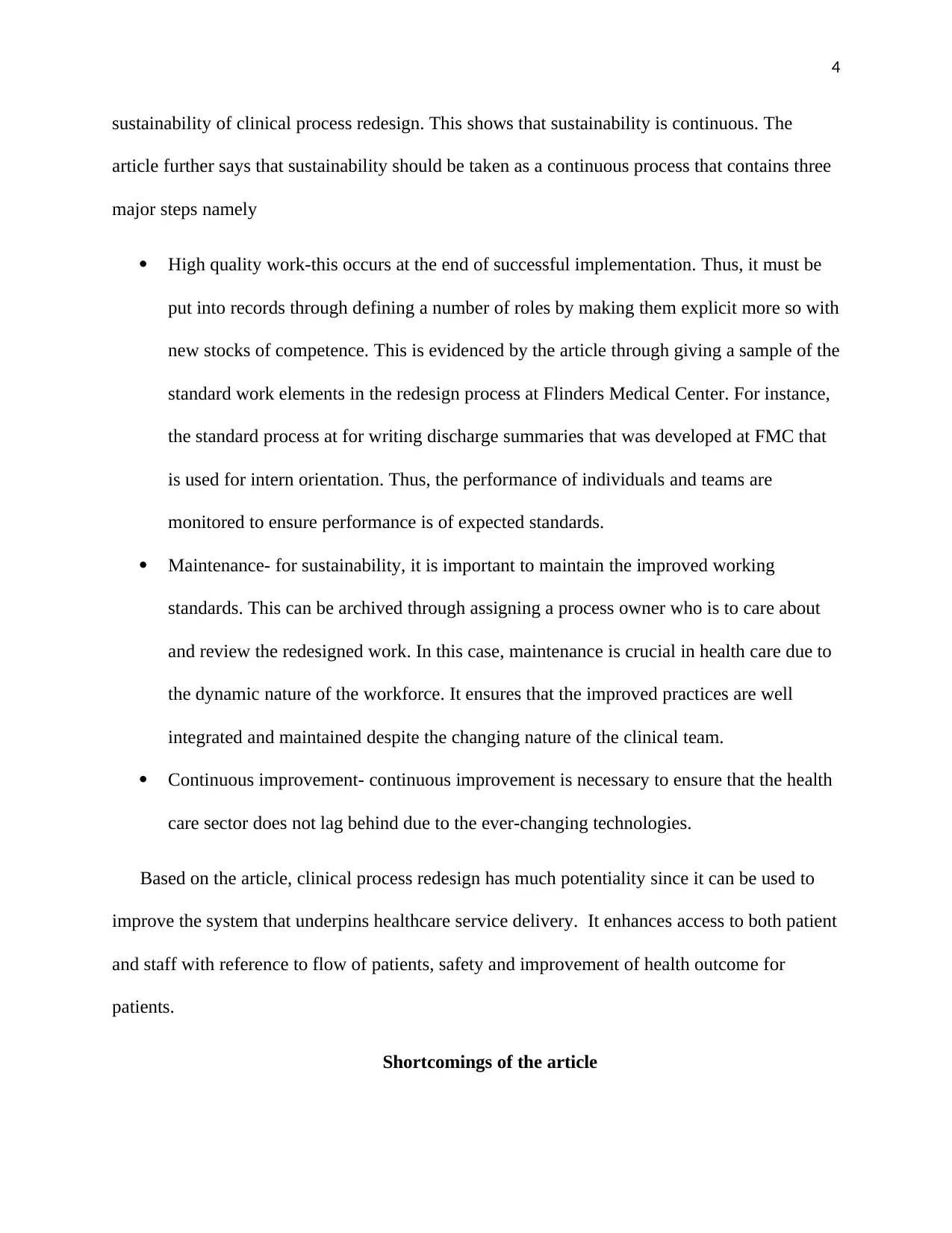
4
sustainability of clinical process redesign. This shows that sustainability is continuous. The
article further says that sustainability should be taken as a continuous process that contains three
major steps namely
High quality work-this occurs at the end of successful implementation. Thus, it must be
put into records through defining a number of roles by making them explicit more so with
new stocks of competence. This is evidenced by the article through giving a sample of the
standard work elements in the redesign process at Flinders Medical Center. For instance,
the standard process at for writing discharge summaries that was developed at FMC that
is used for intern orientation. Thus, the performance of individuals and teams are
monitored to ensure performance is of expected standards.
Maintenance- for sustainability, it is important to maintain the improved working
standards. This can be archived through assigning a process owner who is to care about
and review the redesigned work. In this case, maintenance is crucial in health care due to
the dynamic nature of the workforce. It ensures that the improved practices are well
integrated and maintained despite the changing nature of the clinical team.
Continuous improvement- continuous improvement is necessary to ensure that the health
care sector does not lag behind due to the ever-changing technologies.
Based on the article, clinical process redesign has much potentiality since it can be used to
improve the system that underpins healthcare service delivery. It enhances access to both patient
and staff with reference to flow of patients, safety and improvement of health outcome for
patients.
Shortcomings of the article
sustainability of clinical process redesign. This shows that sustainability is continuous. The
article further says that sustainability should be taken as a continuous process that contains three
major steps namely
High quality work-this occurs at the end of successful implementation. Thus, it must be
put into records through defining a number of roles by making them explicit more so with
new stocks of competence. This is evidenced by the article through giving a sample of the
standard work elements in the redesign process at Flinders Medical Center. For instance,
the standard process at for writing discharge summaries that was developed at FMC that
is used for intern orientation. Thus, the performance of individuals and teams are
monitored to ensure performance is of expected standards.
Maintenance- for sustainability, it is important to maintain the improved working
standards. This can be archived through assigning a process owner who is to care about
and review the redesigned work. In this case, maintenance is crucial in health care due to
the dynamic nature of the workforce. It ensures that the improved practices are well
integrated and maintained despite the changing nature of the clinical team.
Continuous improvement- continuous improvement is necessary to ensure that the health
care sector does not lag behind due to the ever-changing technologies.
Based on the article, clinical process redesign has much potentiality since it can be used to
improve the system that underpins healthcare service delivery. It enhances access to both patient
and staff with reference to flow of patients, safety and improvement of health outcome for
patients.
Shortcomings of the article
Paraphrase This Document
Need a fresh take? Get an instant paraphrase of this document with our AI Paraphraser
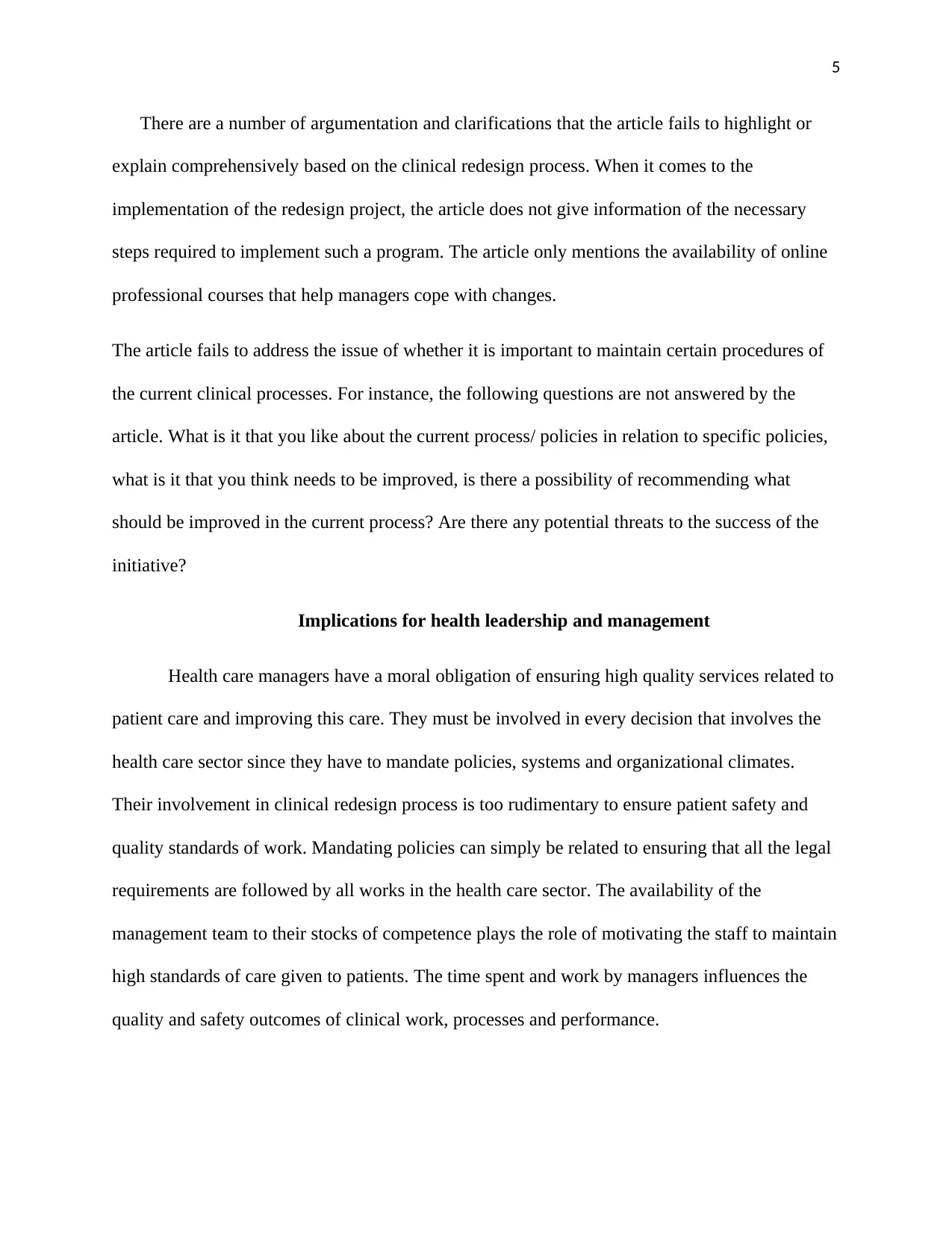
5
There are a number of argumentation and clarifications that the article fails to highlight or
explain comprehensively based on the clinical redesign process. When it comes to the
implementation of the redesign project, the article does not give information of the necessary
steps required to implement such a program. The article only mentions the availability of online
professional courses that help managers cope with changes.
The article fails to address the issue of whether it is important to maintain certain procedures of
the current clinical processes. For instance, the following questions are not answered by the
article. What is it that you like about the current process/ policies in relation to specific policies,
what is it that you think needs to be improved, is there a possibility of recommending what
should be improved in the current process? Are there any potential threats to the success of the
initiative?
Implications for health leadership and management
Health care managers have a moral obligation of ensuring high quality services related to
patient care and improving this care. They must be involved in every decision that involves the
health care sector since they have to mandate policies, systems and organizational climates.
Their involvement in clinical redesign process is too rudimentary to ensure patient safety and
quality standards of work. Mandating policies can simply be related to ensuring that all the legal
requirements are followed by all works in the health care sector. The availability of the
management team to their stocks of competence plays the role of motivating the staff to maintain
high standards of care given to patients. The time spent and work by managers influences the
quality and safety outcomes of clinical work, processes and performance.
There are a number of argumentation and clarifications that the article fails to highlight or
explain comprehensively based on the clinical redesign process. When it comes to the
implementation of the redesign project, the article does not give information of the necessary
steps required to implement such a program. The article only mentions the availability of online
professional courses that help managers cope with changes.
The article fails to address the issue of whether it is important to maintain certain procedures of
the current clinical processes. For instance, the following questions are not answered by the
article. What is it that you like about the current process/ policies in relation to specific policies,
what is it that you think needs to be improved, is there a possibility of recommending what
should be improved in the current process? Are there any potential threats to the success of the
initiative?
Implications for health leadership and management
Health care managers have a moral obligation of ensuring high quality services related to
patient care and improving this care. They must be involved in every decision that involves the
health care sector since they have to mandate policies, systems and organizational climates.
Their involvement in clinical redesign process is too rudimentary to ensure patient safety and
quality standards of work. Mandating policies can simply be related to ensuring that all the legal
requirements are followed by all works in the health care sector. The availability of the
management team to their stocks of competence plays the role of motivating the staff to maintain
high standards of care given to patients. The time spent and work by managers influences the
quality and safety outcomes of clinical work, processes and performance.
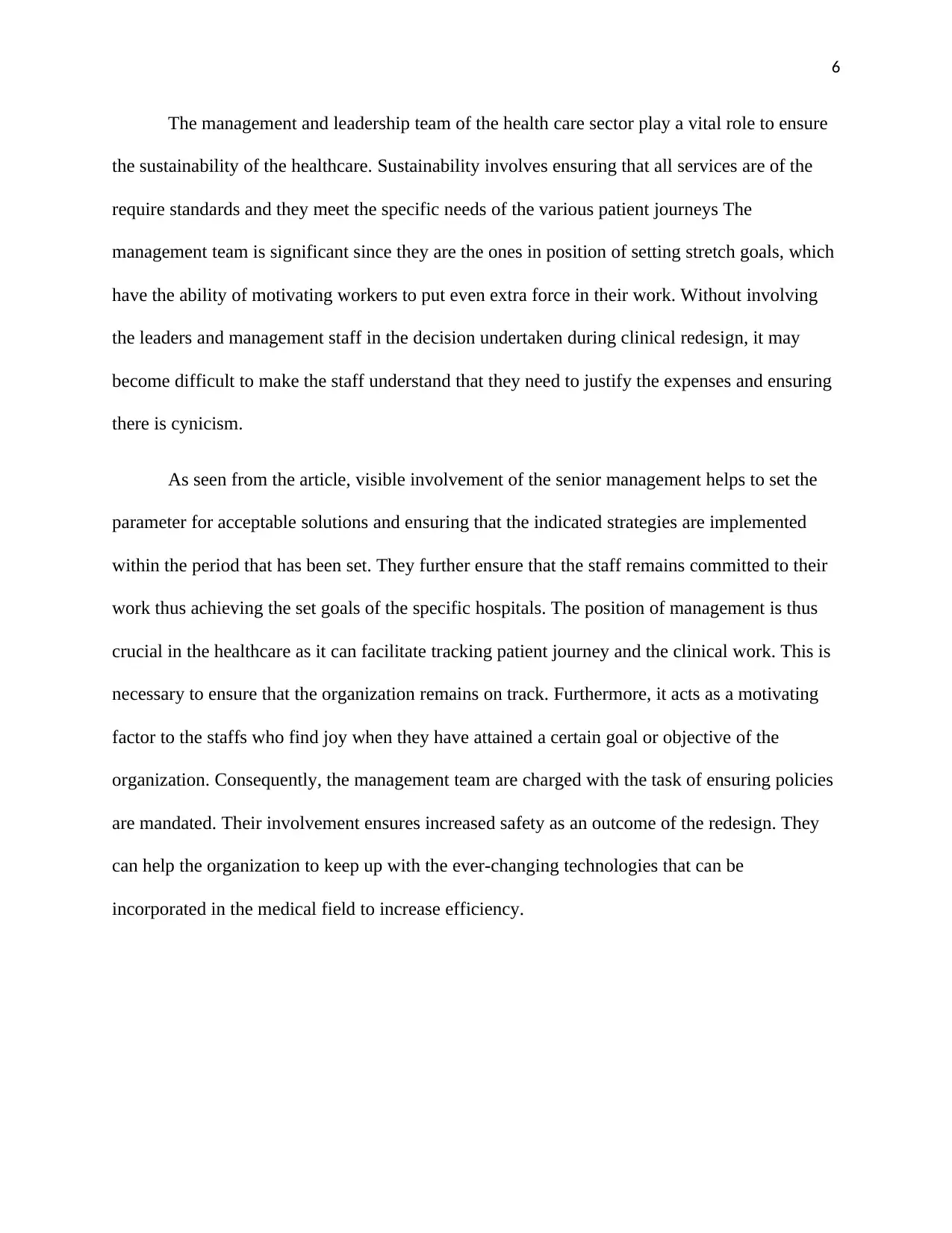
6
The management and leadership team of the health care sector play a vital role to ensure
the sustainability of the healthcare. Sustainability involves ensuring that all services are of the
require standards and they meet the specific needs of the various patient journeys The
management team is significant since they are the ones in position of setting stretch goals, which
have the ability of motivating workers to put even extra force in their work. Without involving
the leaders and management staff in the decision undertaken during clinical redesign, it may
become difficult to make the staff understand that they need to justify the expenses and ensuring
there is cynicism.
As seen from the article, visible involvement of the senior management helps to set the
parameter for acceptable solutions and ensuring that the indicated strategies are implemented
within the period that has been set. They further ensure that the staff remains committed to their
work thus achieving the set goals of the specific hospitals. The position of management is thus
crucial in the healthcare as it can facilitate tracking patient journey and the clinical work. This is
necessary to ensure that the organization remains on track. Furthermore, it acts as a motivating
factor to the staffs who find joy when they have attained a certain goal or objective of the
organization. Consequently, the management team are charged with the task of ensuring policies
are mandated. Their involvement ensures increased safety as an outcome of the redesign. They
can help the organization to keep up with the ever-changing technologies that can be
incorporated in the medical field to increase efficiency.
The management and leadership team of the health care sector play a vital role to ensure
the sustainability of the healthcare. Sustainability involves ensuring that all services are of the
require standards and they meet the specific needs of the various patient journeys The
management team is significant since they are the ones in position of setting stretch goals, which
have the ability of motivating workers to put even extra force in their work. Without involving
the leaders and management staff in the decision undertaken during clinical redesign, it may
become difficult to make the staff understand that they need to justify the expenses and ensuring
there is cynicism.
As seen from the article, visible involvement of the senior management helps to set the
parameter for acceptable solutions and ensuring that the indicated strategies are implemented
within the period that has been set. They further ensure that the staff remains committed to their
work thus achieving the set goals of the specific hospitals. The position of management is thus
crucial in the healthcare as it can facilitate tracking patient journey and the clinical work. This is
necessary to ensure that the organization remains on track. Furthermore, it acts as a motivating
factor to the staffs who find joy when they have attained a certain goal or objective of the
organization. Consequently, the management team are charged with the task of ensuring policies
are mandated. Their involvement ensures increased safety as an outcome of the redesign. They
can help the organization to keep up with the ever-changing technologies that can be
incorporated in the medical field to increase efficiency.
⊘ This is a preview!⊘
Do you want full access?
Subscribe today to unlock all pages.

Trusted by 1+ million students worldwide

7
Bibliography
McGrath, K. M., Denise M. B., David I.T., Boyages S.C., Nigel J., L. and O’Connell, T., Med J
Aust Implementing and sustaining transformational changes in health care:
Lessons learnt about process redesign. 2008; 188 (6): S32.
Bibliography
McGrath, K. M., Denise M. B., David I.T., Boyages S.C., Nigel J., L. and O’Connell, T., Med J
Aust Implementing and sustaining transformational changes in health care:
Lessons learnt about process redesign. 2008; 188 (6): S32.
1 out of 7
Related Documents
Your All-in-One AI-Powered Toolkit for Academic Success.
+13062052269
info@desklib.com
Available 24*7 on WhatsApp / Email
![[object Object]](/_next/static/media/star-bottom.7253800d.svg)
Unlock your academic potential
Copyright © 2020–2025 A2Z Services. All Rights Reserved. Developed and managed by ZUCOL.





